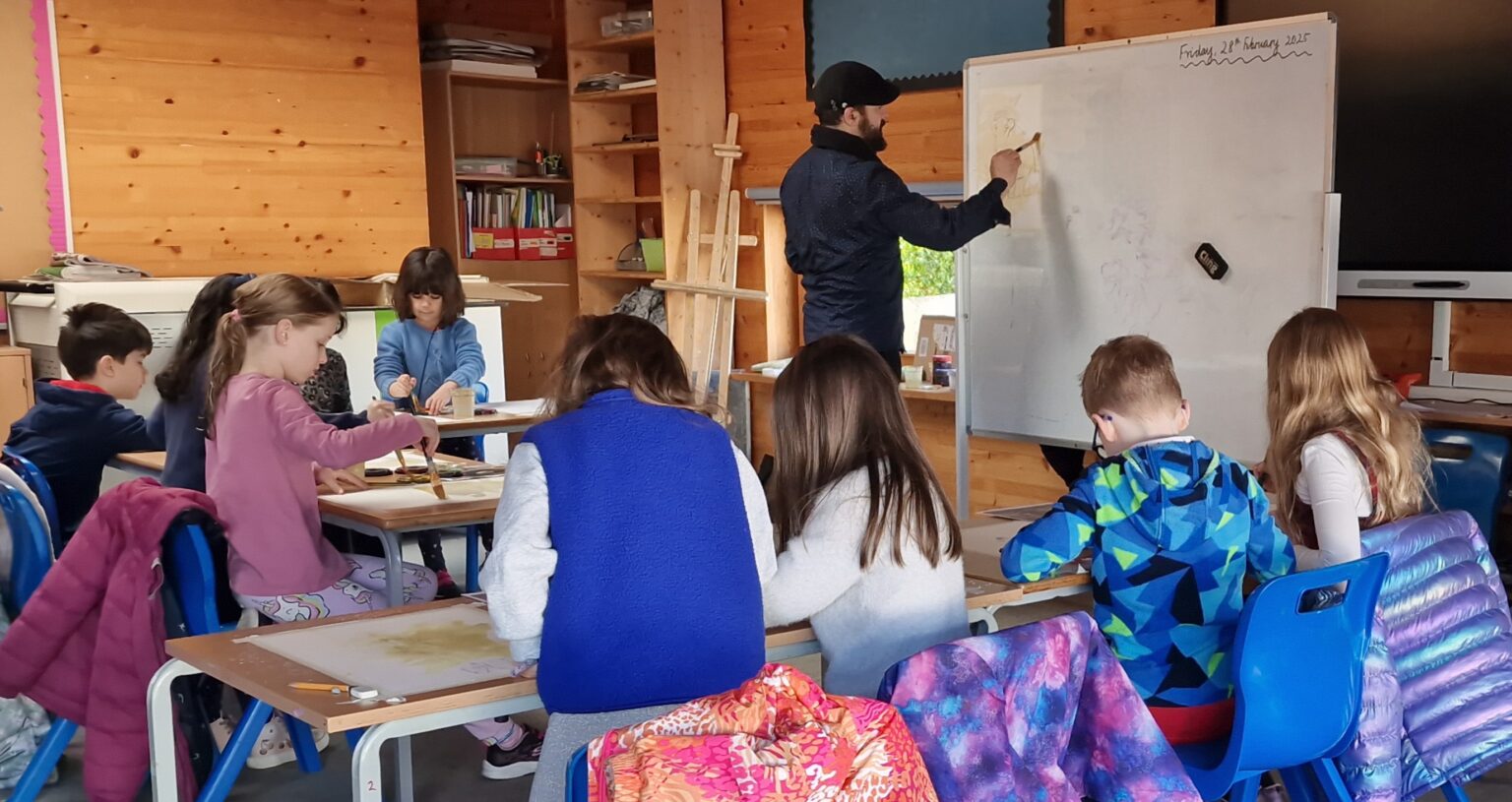
Art Classes - Summer Term - Symbiosis: Mutualism
In the Summer term we will be exploring Symbiosis (Mutualism) in nature, using various artistic techniques and mediums, focusing on shapes, colours and their functions within the natural world.
Symbiosis is a close relationship between two different kinds of organisms, or living things. There are three different types:
- Mutualism is a relationship in which both organisms benefit.
- Parasitism is a relationship in which one organism benefits but the other is harmed
- Commensalism is a relationship in which one organism benefits but the other is neither helped nor harmed.

Coral and Algae- Oil Pastels
- Mutualistic
- Relationship began more than 210 million years ago, in the Triassic Period
- It provides algae with shelter, gives coral reefs their colors and supplies both organisms with nutrients.
- The algae use photosynthesis to produce nutrients, many of which they pass to the corals’ cells. The corals then emit waste products in the form of ammonium, which the algae consume as a nutrient.
- This relationship keeps the nutrients recycling within the coral rather than drifting away in ocean currents and can greatly increase the coral’s food supply. Symbiosis also helps build reefs — corals that host algae can deposit calcium carbonate, the hard skeleton that forms the reefs, up to 10 times faster than non-symbiotic corals.
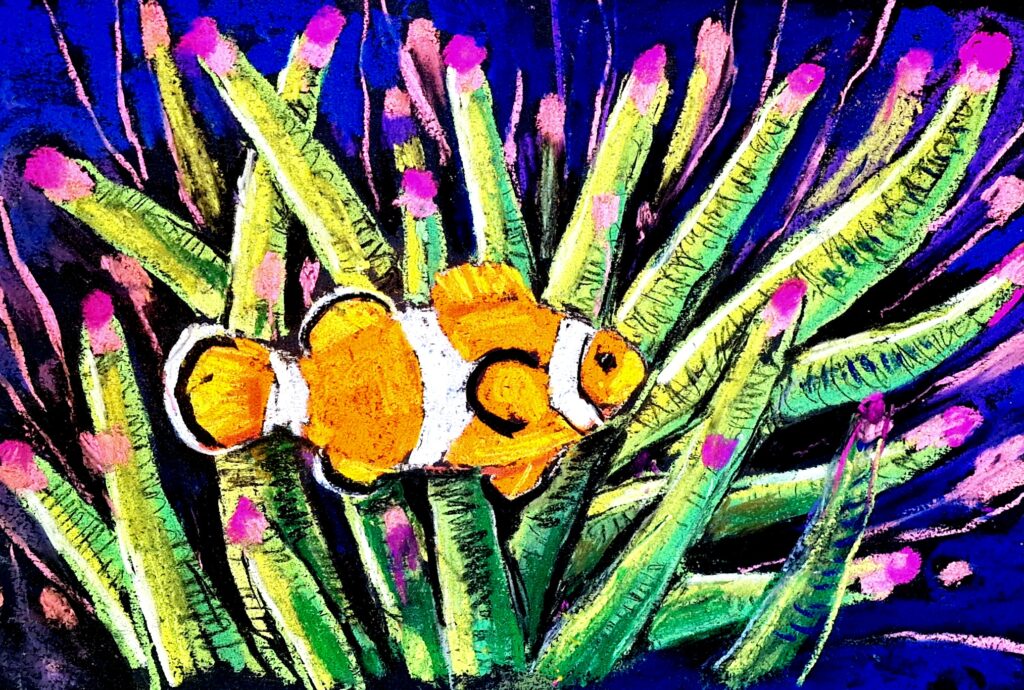
Clownfish and Sea Anemone – Soft Pastels
- Clownfish and Anemone are mutualistic. Clownfish receive a safe place to live and even prey to eat, and in return clownfish provide food to the anemone, help rid it of harmful parasites, and chase away fish like butterflyfish that feed on anemones.
- Sea anemone are marine predatory animals related to jellies and corals. They usually fixate themselves to a hard surface where they remain for the rest of their lives.
- Clownfish are vibrantly colored reef fish that live throughout the Pacific Ocean near Australia, Southeast Asia, Southern Japan, and in the National Marine Sanctuary of American Samoa. These fish are one of the few species that can survive the sting of an anemone – all thanks to a protective layer of mucus that covers their bodies.
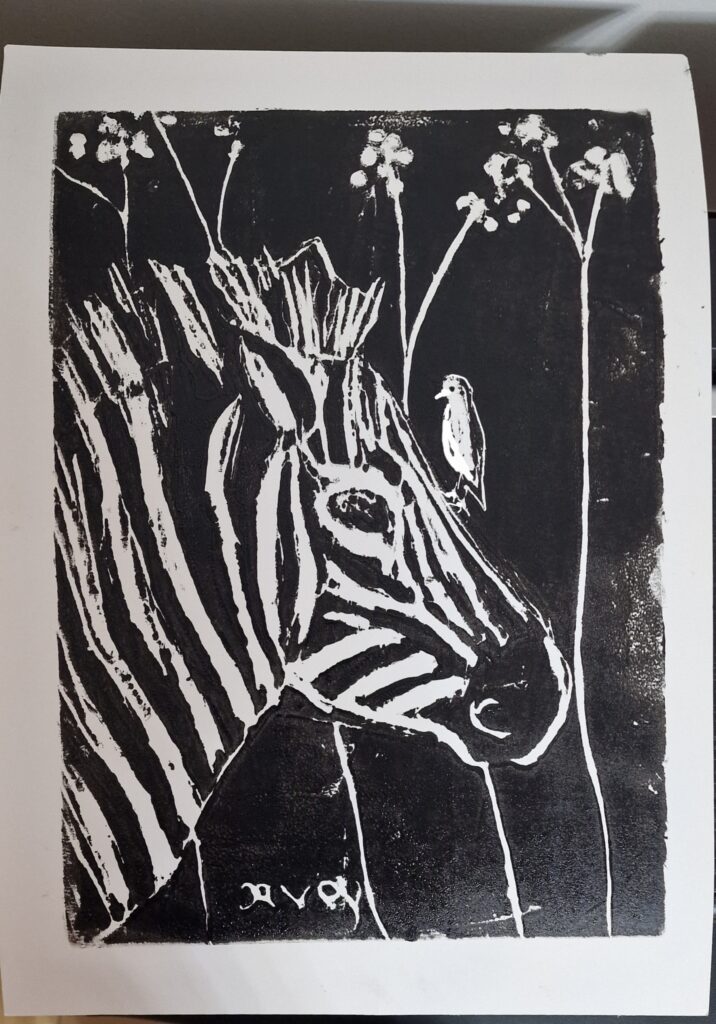
Oxpecker and large mammals (Zebra)- Printing with black ink.
- Mutualistic
- The birds pick at parasites on the mammal’s body, including ticks and blood-sucking flies.The bird gets a meal and the mammal gets parasites removed.
- Oxpeckers will raise the alarm and warn their hosts of impending danger. People have observed that the birds will help hosts such as rhinos (which are short-sighted) evade humans.
- They regularly spend time clinging to large grazing mammals such as wildebeest, rhinos and zebras.
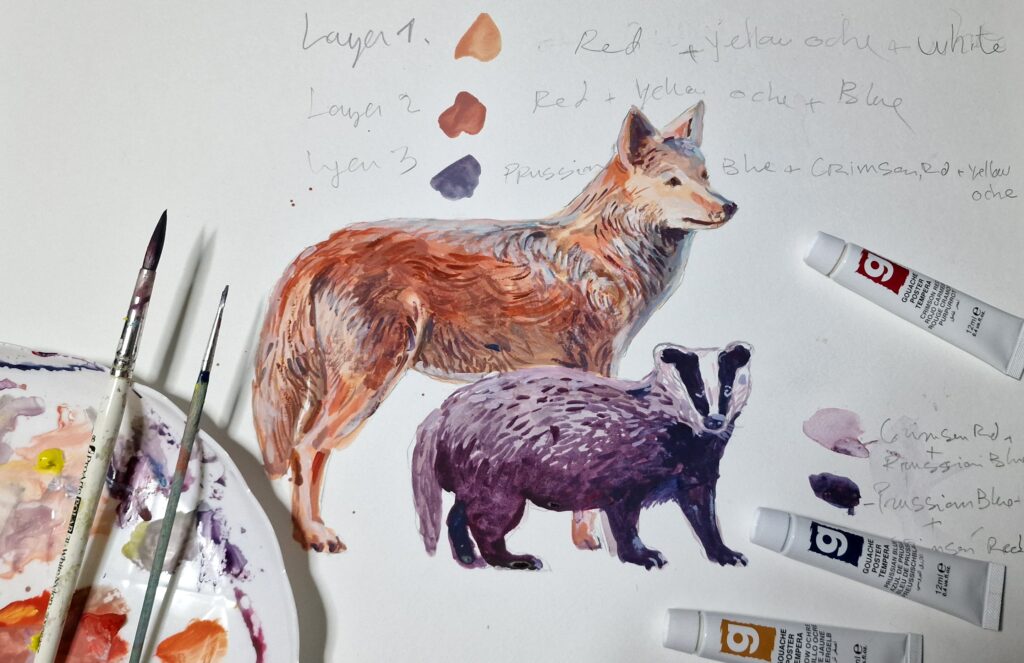
Coyote and Badger – Gouache
- Mutualistic
- Both carnivores with a different set of skills so hunted together – improving the likelihood of at least one of them getting prey
- Coyotes are nimble and quick, so they excel at chasing prey across an open prairie. Badgers are slow and awkward runners by comparison, but they’re better diggers than coyotes, having evolved to pursue small animals in underground burrow systems. So when hunting prairie dogs or ground squirrels on their own, badgers usually dig them up, while coyotes chase and pounce.
- Found primarily in the Great Plains region of North America.
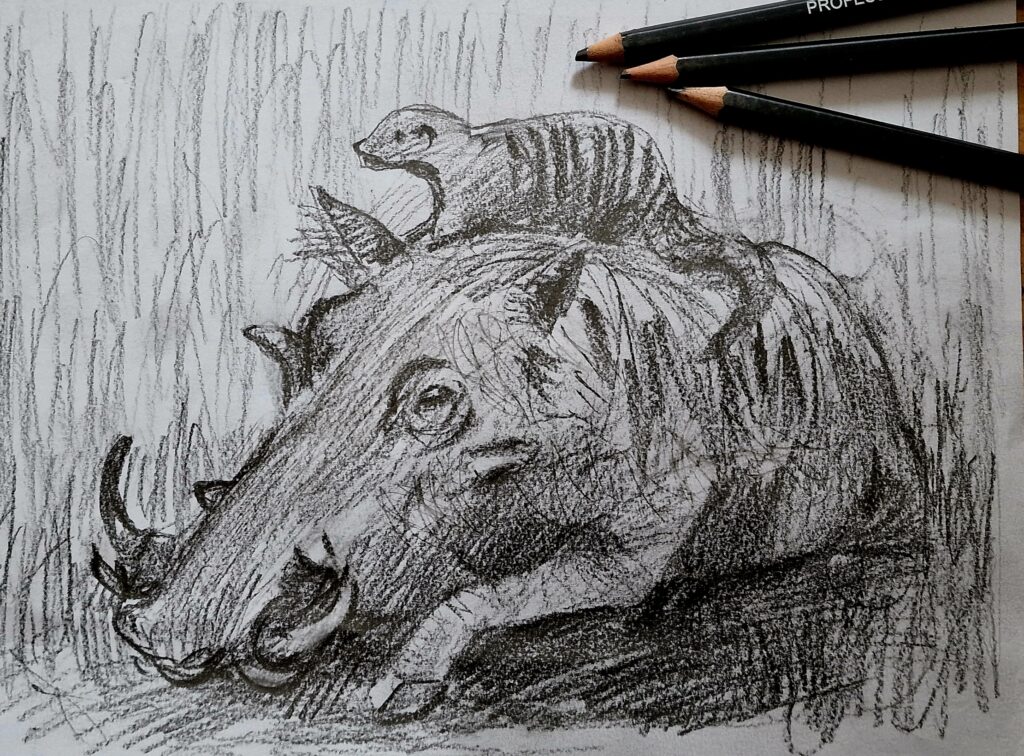
Warthog and Mongoose – Pencil
- Mutualistic
- Both carnivores with a different set of skills so hunted together – improving the likelihood of at least one of them getting prey
- Coyotes are nimble and quick, so they excel at chasing prey across an open prairie. Badgers are slow and awkward runners by comparison, but they’re better diggers than coyotes, having evolved to pursue small animals in underground burrow systems. So when hunting prairie dogs or ground squirrels on their own, badgers usually dig them up, while coyotes chase and pounce.
- Found primarily in the Great Plains region of North America.
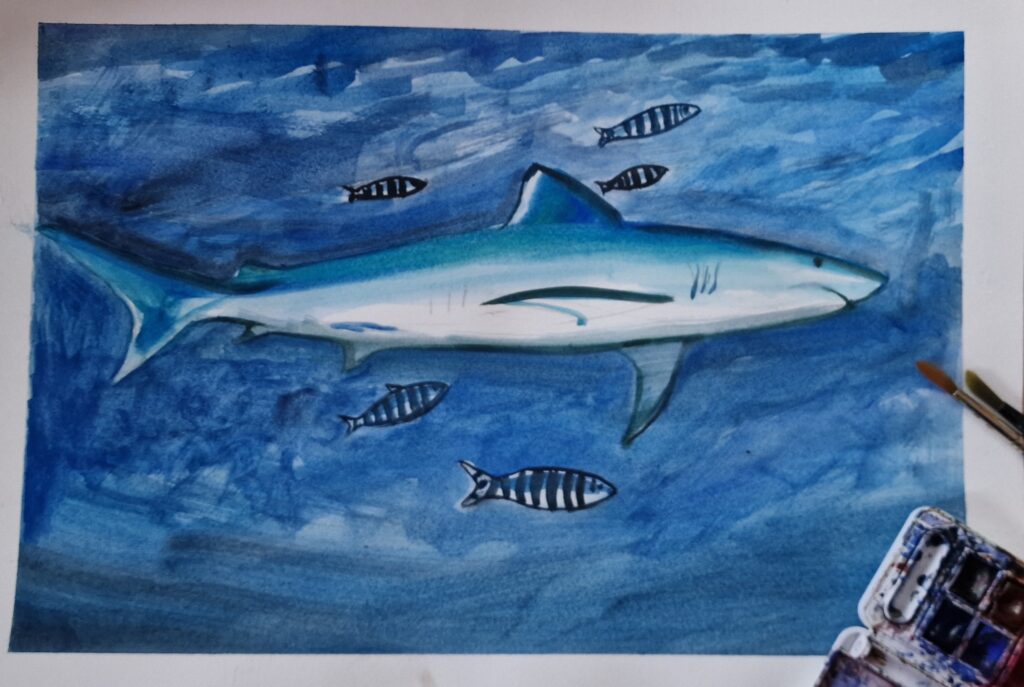
Shark and Pilot fish- Watercolour
- Mutualistic
- The pilot fish is protected from predators white the shark is freed from parasites
- Smaller pilot fish are frequently ssen swimming into sharks’ mouths to clean away fragments of food from between their teeth.
- Pilot fish can be seen with all sharks, but prefer the company of the oceanic whitetip shark, inhabiting tropical and warm temperate seas.
- Pilot fish are also known to follow ships, sometimes for long distances , and many pilot fish have been sighted on the shores of England.
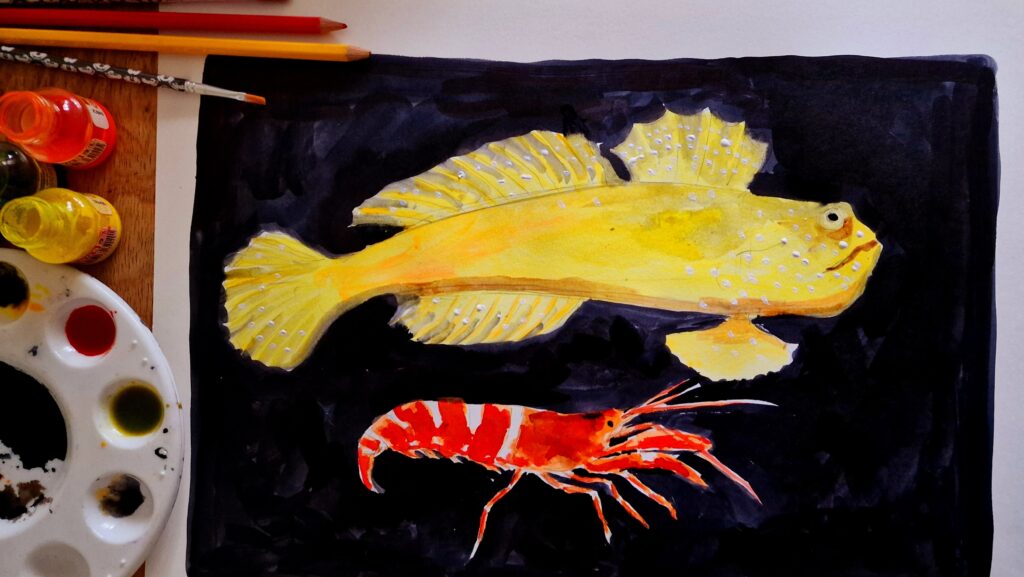
Pistol Shrimp and Goby Fish- Inks
- Mutualistic
- The goby benefits from the shrimp’s digging and construction skills, having access to a well-built burrow. Pistol shrimps have poor eyesight, and they use gobies as an early warning system to detect predators.
- Pistol shrimp are named for the loud snapping sound and startling jet of water which result from the rapid closing of their modified claw. This behavior is primarily a defense mechanism against predatory fish.
- During the day, the goby hovers above the burrow, feeding and interacting with other gobies. Meanwhile, the shrimp uses its antennae to stay in constant contact with the goby’s tail while searching for food (detritus, tiny crustaceans and worms) and maintaining the burrow opening. If a predatory fish approaches, the goby flicks its tail several times, alerting the shrimp to retreat into the burrow. If the predator comes within striking distance, the goby will dart headfirst into the burrow. During the night, the two simply rest together in the burrow.
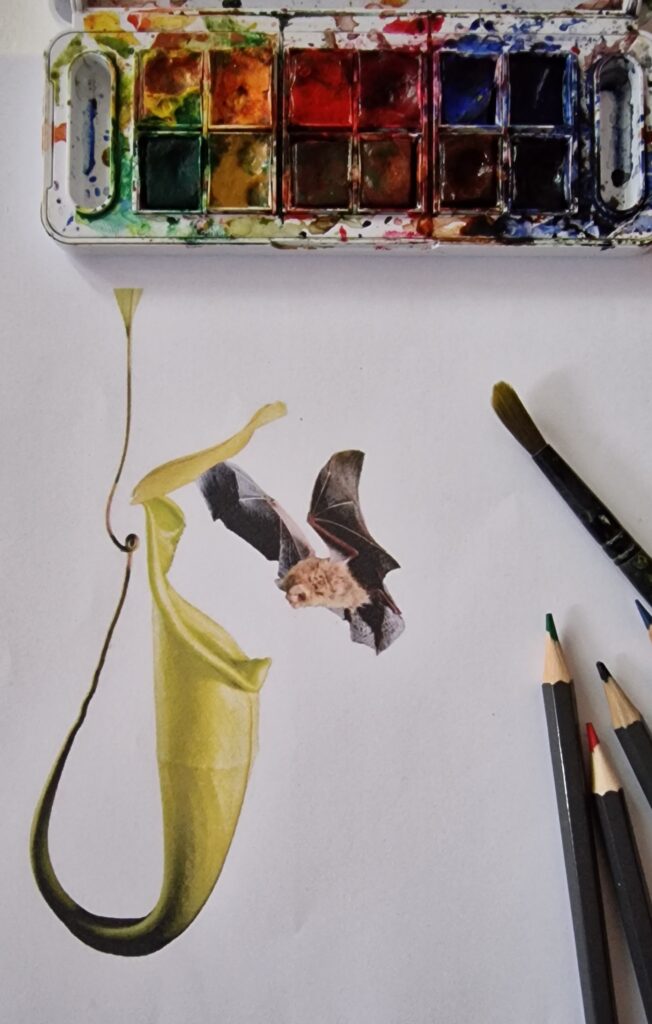
Woolly Bat and Pitcher Plant- Crayons & watercolour
- Mutualistic
- Woolly bats sleep in the pitcher plant during the day, and poop there, providing nitrogen for the plant. These pitchers have an unusual shape that makes them not only ideal for a sleeping bat, but also easily detected by echolocation.
- The inner wall of the pitcher has a waxy texture that deters egg-laying insects, providing a pest-free home for the bats.
- The pitcher plant is highly dependent on the bat, as this pitcher is not particularly good at catching insects.
- They are found in southern parts of Mexico and extend through Northeastern South America.

Mycorrhizae: The Symbiotic Relationship between Fungi and Tree Roots- Clay
- Mutualistic
- Because nutrients are often depleted in the soil, most plants form symbiotic relationships called mycorrhizae with fungi that integrate into the plant’s root.
- The relationship between plants and fungi is symbiotic because the plant obtains phosphate and other minerals through the fungus, while the fungus obtains sugars from the plant root.
- The long extensions of the fungus, called hyphae, help increase the surface area of the plant root system so that it can extend beyond the area of nutrient depletion.
- Ectomycorrhizae are a type of mycorrhizae that form a dense sheath around the plant roots, called a mantle, from which the hyphae grow; in endomycorrhizae, mycelium is embedded within the root tissue, as opposed to forming a sheath around it.
- In endomycorrhizae, mycelium is embedded within the root tissue, as opposed to forming a sheath around it; these are found in the roots of most terrestrial plants.
Key Terms
- mycorrhiza: a symbiotic association between a fungus and the roots of a vascular plant
- hypha: a long, branching, filamentous structure of a fungus that is the main mode of vegetative growth
- mycelium: the vegetative part of any fungus, consisting of a mass of branching, threadlike hyphae, often undergroun
Art classes are 1 hour Duration. Materials included
Subscription:
Strand Art school term time classes are paid via monthly subscription through Classforkids portal. Instead of one large amount, the fee is split into affordable payments on the 1st of each month. Each payment covers 2.5 classes:
If joining after the start of term you will only pay for the classes after this date. It is only possible to book for the full/ remainder of the term. To cancel your place and subscription, simply let us know at least 30 days before the start of the new term.
Strand Art school terms are 10 weeks. In the longer Autumn term, we offer two weeks of Xmas-themed classes at the end, charged at an additional rate on your November payment. Students are automatically opted into these, but may opt out if they would prefer not to join.
Don’t hesitate to get in touch with any questions!
Prices include all materials
